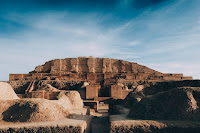Food Offered to Idols

Upon his arrival in the imperial city, Daniel was confronted with a predicament. If he consumed the food and drink of the pagan king, it would violate his ritual purity. While he might have wished to avoid eating “unclean” meats, more likely, his concern was that consuming the royal “delicacies” would mean his participation in the idolatrous rituals of the Babylonian court and religion. Either way, the young man's decision could have dire consequences.






